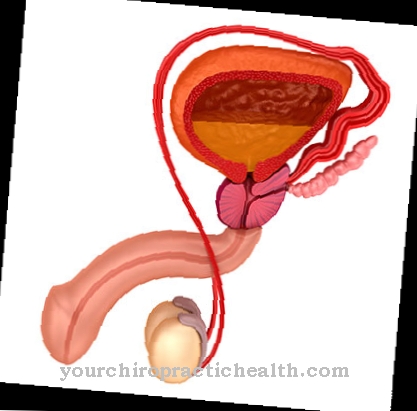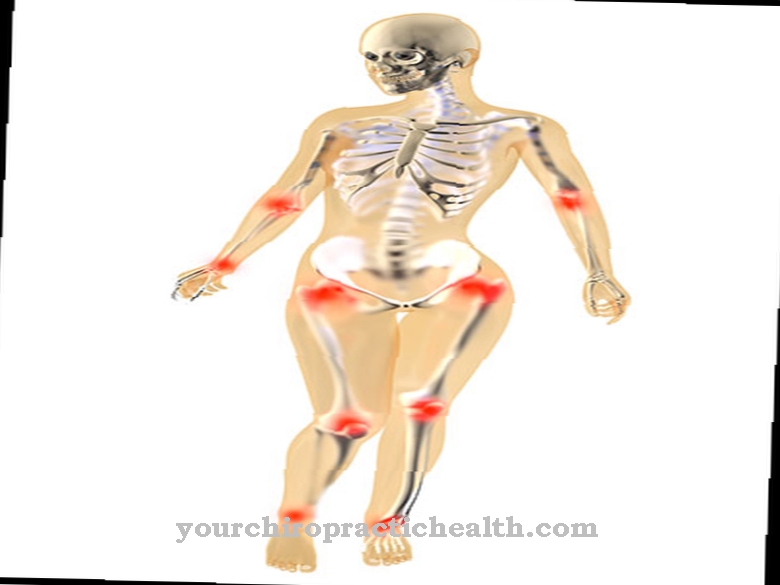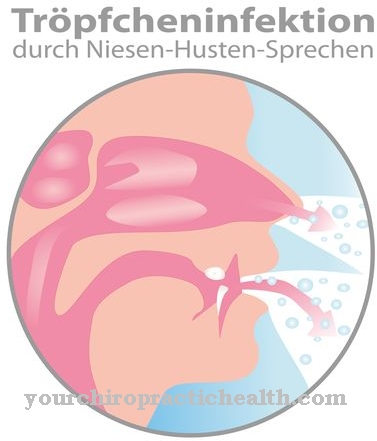As one Inflammation of the gallbladder (cholecystitis) is an inflammation of the gallbladder wall. The most common cause is already existing gallstones. In this case, one speaks of acute gallbladder inflammation. Typical signs of a gallbladder infection are fever and abdominal pain (especially in the upper abdomen). Sometimes the pain can radiate to the chest or shoulder.
What is gallbladder infection?

© Henrie - stock.adobe.com
Inflammation of the gallbladder (cholecystitis) is a common disease in middle and older age. The female gender is clearly preferred. Symptoms include massive pain in the right upper abdomen. These are often so strong that breathing is stopped reflexively when the gallbladder is palpated (Murphy's sign).
The pain often radiates into the shoulder or between the shoulder blades. Loss of appetite, nausea, vomiting, and sweating are also typical. Complications (sepsis, pancreatitis) can lead to a high fever, possibly with chills.
If the stool discolors and the urine color is dark at the same time, there may be biliary blockage (cholestasis). The "coloring" bilirubin in the bile is then alternatively excreted via the kidneys. The diagnosis is made through the physical examination, the laboratory (inflammatory constellation, cholestasis parameters such as AP, bilirubin and gamma-GT) and ultrasound.
causes
In up to 95 percent of cases of inflammation of the gallbladder, the cause is gallstone disease. Accordingly, patients with the well-known five F's are often affected: female (female), forty (age at or over 40), fat (overweight), fertile (fertile) and fair (blond or light skin color). In addition, there is a family disposition.
The stones in the gallbladder either mechanically irritate the gallbladder wall (abacterial inflammation) or can get stuck in the duct and block it. The bile backs up and expands the gallbladder (hydrops). In addition to mechanical irritation, ascending intestinal germs (e.g. E. coli) can then lead to inflammation.
Other causes are rare, e.g. toxic substances, chronic haemolysis (with the formation of bilirubin gallstones), trauma, diseases of the bile ducts, long-term parenteral nutrition, transmitted infections from e.g. the liver or tumors in the gallbladder.
Symptoms, ailments & signs
The symptoms of gallbladder inflammation depend on both the age of the affected person and whether it is acute or chronic cholecystitis. Typical symptoms of acute gallbladder inflammation are pain that slowly migrates from the upper abdominal regions (above the stomach) to the entire right upper abdomen. At first, the pain usually appears as so-called biliary colic in convulsive waves.
Then they intensify into a persistent pain in the right upper abdomen lasting several hours. The pain can radiate to the shoulder or back. Under pressure it increases. In addition to abdominal pain, some patients also suffer from nausea, vomiting, loss of appetite, fever or palpitations. If the biliary tract is involved, jaundice with yellowing of the eyes and skin often occurs.
In addition to similar symptoms, young children develop jaundice more quickly than adults. The stool often turns white to gray. Older children are more likely to experience nausea and vomiting. Instead of upper abdominal pain, you initially feel an uncomfortable feeling of pressure, which increases into cramp-like pain.
Older patients often have no pain at all. They only complain of tiredness and fatigue. If they still experience pain, then it is mild upper abdominal pain together with gas. Chronic gallbladder inflammation is characterized by symptoms similar to those in elderly patients.
course
If a gallbladder infection is not treated as quickly as possible, it can lead to serious complications. Recurring gallbladder inflammation soon turns out to be chronic. Furthermore, a gallbladder rupture (perforation) or even the bursting of the gallbladder can occur. These complications should not be taken lightly as they can be life-threatening conditions.
Complications
In the context of a gallbladder inflammation there is a risk of various complications. There is a particular risk of sequelae if cholecystitis is treated late. This can lead to a build-up of pus in the gallbladder. In addition, if the pressure on the wall of the gallbladder increases, it can break open. Doctors then speak of a perforation.
If the bile and bacteria get into the peritoneum as a result, this in turn leads to peritonitis (peritonitis), which even has life-threatening consequences. Another dangerous complication is the leaking of bacteria from the gallbladder into the bloodstream, causing inflammation. In such cases there is a risk of blood poisoning (sepsis), which can spread to the entire body of the patient.
If the inflamed gallbladder wall is broken through at a certain point along the intestine, it is possible that a fistula will form that connects both organs. Occasionally, a gallstone can enter the intestine and cause an intestinal blockage, which in turn causes a life-threatening intestinal obstruction that requires rapid surgery.
Jaundice (jaundice) is also one of the sequelae of gallbladder inflammation. This occurs because the bile pigment bilirubin can no longer drain due to stuck gallstones. In addition, the bile secretions accumulate in the liver. This in turn causes infections such as liver inflammation or liver abscesses.
When should you go to the doctor?
Pain that occurs in the area of the upper or middle abdomen is an occasion to consult a doctor. If the symptoms persist for several days or if they intensify, a doctor is required. If cramps occur or if the pain leads to a stooped posture, a medical evaluation of the symptoms should take place. In the event of symptoms such as fever, nausea, vomiting or diarrhea, a doctor should be consulted as soon as they recur or persist for several days.
A bowel obstruction is cause for concern. A doctor should be consulted so that the cause can be determined. If the person concerned suffers from a general feeling of illness or a decrease in their usual performance, they should contact a doctor. If daily obligations can no longer be fulfilled due to the symptoms, it is also necessary to consult a doctor. Before taking any pain medication, it is necessary to consult a doctor in order to rule out further complications.
If there is loss of appetite, listlessness or general malaise, a doctor's visit is necessary if the symptoms persist for several weeks. In the event of acute symptoms that appear suddenly and unexpectedly, a doctor should be consulted immediately. In severe cases, it is advisable to inform the emergency services and to follow their instructions.
Doctors & therapists in your area
Treatment & Therapy
The therapy for gallbladder inflammation depends on the extent of the disease. Inpatient conservative treatment is preferred. This is done intravenously with biliary antibiotics, usually as a combination therapy of two antibacterial agents. In addition, pain relievers (also with antispasmodic components, e.g. butylscopolamine or metamizole) and physical measures should be used (most patients find an ice blister soothing).
In severe cases or in the generalized stage (chologene sepsis), strict bed rest is recommended. Once the acute infection has healed, surgical gallbladder removal (cholecystectomy) is performed. This is necessary because the triggering risk factors (e.g. gallstones) are still present and a relapse is likely. Elective cholecystectomy is usually performed in a minimally invasive manner using a laparoscopy. Two to three small cuts are necessary for this.
An early discharge from the hospital and mobilization and accordingly fewer complications are possible thanks to the gentle procedure. If an isolated, jammed stone is the cause, ERCP (endoscopic retrograde cholangiopancreatography, an invasive procedure similar to gastroscopy) plus antibiotic therapy may be sufficient. If there are already complications or if conservative therapy was unsuccessful, surgery must be performed during the florid inflammation.
Outlook & forecast
The prognosis of gallbladder inflammation is considered favorable with early and good treatment. If gallstones are the cause of the inflammatory process, they must be removed so that permanent symptom relief is possible. Otherwise, the course will be chronic.
If the stones are removed without any further complications, the inflammation is treated with medication until complete recovery. If gallstones and gallbladder inflammation recur in the course of life, the prognosis is also optimistic. Nevertheless, the possible removal of the gallbladder should be considered if the disease recurs.
In the case of acute gallbladder inflammation, the gallbladder is removed in a surgical procedure so that the patient's life is not exposed to unnecessary danger. Although it is an operation with the usual risks and side effects, the procedure is rarely associated with disorders or secondary diseases. Removal is a routine process in which the patient can be discharged from treatment within a few days.
If the wounds heal as planned, there is lifelong freedom from symptoms before further inflammation of the gallbladder. The person concerned can normally continue his usual lifestyle without the organ. There are no significant impairments or necessary restructuring of the daily routine.
prevention
The most important preventive measure against gallbladder inflammation is avoiding gallstones. This is most likely possible through a diet that is low in fat and cholesterol. Overall, the aim should be to reduce weight to normal. Other risk factors can hardly be influenced.
If biliary colic has occurred for the first time (symptomatic gallstones), a gallbladder removal should be carried out in a symptom-free period. In this way, subsequent colic with the risk of gallbladder inflammation can be prevented.
Aftercare
In the case of gallbladder inflammation, the options for follow-up care are relatively limited in most cases, so that the patient is primarily dependent on medical treatment for this disease. This is in the foreground, with early diagnosis and treatment having a positive effect on the further course of this disease. The inflammation of the gallbladder is usually treated with the help of antibiotics.
There are no particular complications. However, the person affected should ensure that they take antibiotics regularly and avoid alcohol during treatment so as not to weaken the effect of the drugs. Attention should also be paid to the correct dosage and possible interactions with other drugs.
Since gallbladder inflammation can also lead to further complaints or complications, regular examinations by a doctor are advisable even after treatment, for example in order to identify and treat gallstones at an early stage.In some cases, a surgical procedure is necessary, after which the affected person should always rest.
In any case, strenuous or stressful activities should be avoided. The inflammation of the gallbladder can usually be treated well, so that it does not lead to a reduced life expectancy for the person affected.
You can do that yourself
Since in most cases the formation of gallstones leads to gallbladder inflammation, it is important to prevent this in everyday life through a healthy lifestyle. A high-fat and low-fiber diet promotes the formation of gallstones. Therefore, eating habits and food intake should be checked. If possible, these should then be converted.
A vitamin-rich diet with sufficient trace elements and nutrients prevents diseases. The intake of sufficient fluid must be checked and, if necessary, adjusted to the needs of the body. Adequate exercise, sport and maintaining a normal weight are also beneficial. Toxic and harmful substances such as alcohol or nicotine are to be avoided.
In order for the organism to produce enough defenses to fight inflammatory diseases, it needs a stable immune system. In order to function properly, in addition to a healthy diet, factors such as stress, hectic rush and psychological stress must be reduced. Persistent dissatisfaction, pessimism and negative thoughts about the future are a hindrance in the healing process as well as in the prevention of diseases.
If the family has a history of gallbladder inflammation, there is an increased risk of developing the same disease. For this reason, special attention should be paid to the way of life of these people in everyday life. To prevent life-threatening conditions, it is necessary to consult a doctor in good time.



.jpg)









.jpg)

.jpg)
.jpg)











.jpg)